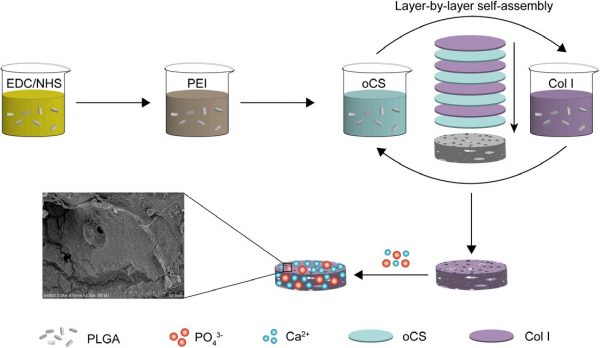生物矿化提高多层改性PLGA多孔支架的力学和成骨性能
J Biomed Mater Res Part A. 2018:9999:1–12
PLGA具有生物安全性、生物可降解性和生物相容性等优点,已被广泛用作骨组织工程的支架材料。然而,PLGA的生物惰性表面可能无法调节细胞行为和指导支架与宿主组织之间的骨整合。 广东医科大学干细胞研究中心以氧化型硫酸软骨素(OCS)和I型胶原(Col I)为黏结剂,通过层层组装技术(LBL)将其组装到PLGA表面。为保证纳米羟基磷灰石(NHAP)的沉积,对多层改性PLGA支架进行了体外矿化。结果表明,与纯PLGA支架相比,NHAP晶体更加均匀、牢固地附着在多层改性PLGA上,从而显著改善了PLGA的表面和力学性能。此外,通过NHAP涂层和多层沉积,PLGA支架的体外生物相容性在骨间充质干细胞(BMSCs)附着、扩散和增殖方面得到了显著增强。此外,所制备的复合支架还显示了通过向上调节成骨标志基因来促进BMSC成骨分化的能力。 Poly-(lactide-co-glycolide acid) (PLGA) has been widely investigated as scaffold material for bone tissue engineering owing to its biosafety, biodegradability, and biocompatibility. However, the bioinert surface of PLGA may fail in regulating cellular behavior and directing osteointegration between the scaffold and the host tissue. Stem Cell Research and Cellular Therapy Center, Affiliated Hospital of Guangdong Medical University, oxidized chondroitin sulfate (oCS) and type I collagen (Col I) were assembled onto PLGA surface via layer by layer technique (LbL) as an adhesive coating for the attachment of inorganic minerals. The multilayer-modified PLGA scaffold was mineralized in vitro to ensure the deposition of nanohydroxyapatite (nHAP). It was found that nHAP crystals were more uniformly and firmly attached on the multilayer-modified PLGA as compared with the pure PLGA scaffold, which remarkably improved PLGA surface and mechanical properties. Additionally, in vitro biocompatibility of PLGA scaffold, in terms of bone mesenchymal stem cells (BMSCs) attachment, spreading and proliferation was greatly enhanced by nHAP coating and multilayer deposition. Furthermore, the fabricated composite scaffold also shows the ability to promote the osteogenic differentiation of BMSCs through the up-regulation of osteogenic marker genes. Thus, this novel biomimetic composite scaffold might achieve a desirable therapeutic result for bone tissue regeneration. 孙嘉阳
|
